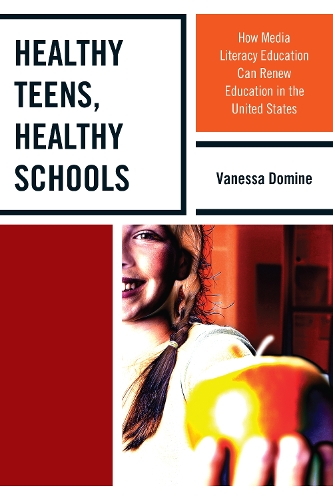
Healthy Teens, Healthy Schools: How Media Literacy Education can Renew Education in the United States
(Hardback)
Available Formats
Publishing Details
Healthy Teens, Healthy Schools: How Media Literacy Education can Renew Education in the United States
By (Author) Vanessa Domine
Bloomsbury Publishing PLC
Rowman & Littlefield Publishers
28th May 2015
United States
Classifications
Professional and Scholarly
Non Fiction
Counselling and care of students
Public health and preventive medicine
Secondary schools
373.1710973
Physical Properties
Hardback
130
Width 163mm, Height 239mm, Spine 16mm
399g
Description
Widespread obesity, poor nutrition, sleep-deprivation, and highly digital and sedentary lifestyles are just a few of the many challenges facing young people. Although public schools in the United States have the potential for meeting these challenges on a mass scale, they are slow to respond. The emphasis on discrete subject areas and standardized test performance offers little in the way of authentic learning and may in reality impede health. Healthy Teens, Healthy Schools: How Media Literacy Education can Renew Education in the United States reframes health education as a complex terrain that resides within a larger ecosystem of historical, social, political, and global economic forces. It calls for a media literate pedagogy that empowers students to be critical consumers, creative producers, and responsible citizens. This book illustrates holistic health education through school-community initiatives and innovative partnerships that are successful in magnifying all curriculum subjects and their associated teaching practices. Vanessa Domine offers teachers, teacher educators, school administrators, community organizers, public health professionals, and policy makers with a transmedia and transdisciplinary educational approach to adolescent health to demonstrate how our collective focus on cultivating healthy teens will ultimately yield healthy schools.
Reviews
In this book, Domine advocates for practices, programs, and interventions that would foster media literacyspecifically health literacyamong adolescent youth. Using a social constructivist approach, Domine examines the historical connections among the adolescent youth culture, media technology, public health, and industrialization. Sheanalyzes data from various sources to summarize the health challenges that adolescent youth currently confrontand shows how the health and health literacy of adolescents have been marginalized, co-opted, and failed by the entwined institutions of public education, business and industry, technology, and politics. Her analysis of the commercialization and politicalization of youth health issues, such as federal school and breakfast programs and physical activity campaigns, is particularly enlightening. Ultimately, the most important contribution of Domines work is her identification and description of effective adolescent health approaches and initiatives. Professionals who focus on adolescent health within the disciplines of public health, health education, and health promotion can find a foundation for their work in this interesting book that illustrates holistic health education through school-community initiatives and innovative partnerships. Summing Up: Recommended. Upper-division undergraduates through professionals and practitioners. * CHOICE *
The health of our youth and our country can benefit immensely from placing copies of this groundbreaking book into the hands of parents, educators, health care providers, and policy makers. Healthy Teens, Healthy Schools provides not just thorough analysis of the health issues facing the US and much of the Western World, it also connects these issues brilliantly within a historical context revealing the past and present role media play in contributing to our current health crisis. While the analysis is insightful, the true power of the book comes from its proactive pedagogical solutions in which Vanessa Domine provides practical advice for how a critical media health literacy education can confront these problems through empowering youth to think critically about the messages they consume and the healthy habits they develop. -- Jeff Share, PhD, UCLA
If you are not concerned about the effects of exposure to electronic media on the health of teenagers, you should be. This book presents a well-researched, highly compelling case for the urgent need for media literacy education to be incorporated into school wellness programs as soon as possible. -- Marion Nestle, professor of Nutrition, Food Studies, and Public Health, New York University; author of What to Eat
Healthy Teens, Healthy Schools offers a holistic look at how mass media, popular culture and digital technologies influence children and teens, and how the practice of media literacy education can help address important health issues issues including nutrition, body image, aggression, sexuality and social relationships. Vanessa Domine situates media literacy as a practice that contributes to the development of smart, engaged and responsive young people. She offers a big-picture perspective that enlightens, informs and inspires readers. This book will enable every teacher to become a health educator, by activating those how and why questions that enable us to see the relationship between our highly-mediated cultural environment, our social relationships, and our individual behaviors, beliefs and attitudes. -- Renee Hobbs, Harrington School of Communication and Media, University of Rhode Island
Author Bio
Vanessa Domine is associate professor in the Department of Secondary and Special Education at Montclair State University and the author of Rethinking Technology in Schools. She holds a doctorate in Media Ecology from New York University and is interested in how media and technology can support democratic practices in education.
